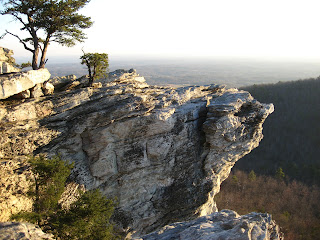L.O.S.T. is Lower Old Scramblers' Trail on the western side of Linville Gorge. Once again, Marshall has meticulously organized our outing on this spectacular route along the the bluffs. Jenny "the blogger" Bennett from Sylva joins Marshall, Dale, Will, Gary and myself for the scramble today. Leaving Jenny's vehicle at Pinch In parking area, we make the bumpy ride up the Kistler Highway to Conley Cove parking area. A short distance down the Conley Cove trail, we follow a well defined path to a large cave, pictured above. Conley Cave appears to be a popular place with several fire rings located in it. One is directly below the crack in the middle of the cave roof, clearly seen above. It looks as though this might serve as a chimney. Along one wall, several spots have been terraced to proved level areas, presumably for sleeping.
From the cave we follow faint trails which have seen some recent maintenance activity. Our route visits Fern Point, Hacker's Point and Blue Jay Point before sliding down a small chute to see One Bat Cave. This cave is smaller than than Conley, perhaps only 30 yards deep but just a few feet wide. Shining my flashlight up, I spot a shaft with light coming through. It appears an animal has built a nest there.
From One Bat Cave, we begin to thrash a bit in the brush, searching for routes. We need to be mindful of where we are. We need to find a long steep chute. Above, Jenny and Marshall cling and slide. Now we're at the base of a rock bluff. It is short distance to Little Seneca one of the highlights of the day.
To pass through here you must use the keyhole shown above. This area has massive rocks piled up under an overhang. It appears something has built nests in the crevices.
Above, our lunch stop is atop this rock jutting out. It is an impressive view. You can't book a table in a restaurant with this view. The walk out on this rock is a bit unnerving. As is normally the case, not everyone is comfortable with this.
Following lunch we begin the climb up Zen Canyon. This is not a technical climb but can be exhausting. Its a jumble of rocks but there are many handholds. Many of these handholds are small rhododendrons. Jenny advised me later it was considered "poor form" in the climbing world to use a "vegetable hold". Above is the Weeping Wall of Zen Canyon.
Looking back down Zen Canyon at my mates, Will is wondering when this will end. That was the easy part. Now we must steeply scramble up in some brush using multiple vegetable holds. Will and I take a wrong turn here and get really bogged down in deadfall and briers. Soon we are reunited for a quick respite at Zen Point. Here you can look down on Razors Edge Rock our next destination.
Will and I decide to head out to Razors Edge Rock while the others visit Razor Point. Above is the narrow route out to Razor's Edge Rock. Below Marshall and Jenny peer down on us.
Once down the chute and out the narrow ledge to Razor's Edge Rock, you have to do a couple short climbs. They aren't terribly difficult but a slip here would not end well, so again a couple of our group stay put.
This is one of my favorite spots in the gorge. You seem suspended out in the gorge, able to see the rock bluffs behind you as well as the giant bluffs across the gorge. We can see folks camped on the opposite side. they are just specks.
The views upriver are spectacular. It is easy to make out the iconic ridgeline of the east side.
Atop the rocks on Razor's Edge, Jenny and Will admire the view. After climbing up here I felt just a little shaky. The moving clouds seem to make the rock bluffs move so like Will, I preferred to sit.
Leaving this area we made out way back to Rock Jock Trail and headed out. The hike out is about an hour and half and passes several other points but we visit only two, Sunshine point and Balanced Rock. The last half hour is up steep trail and it takes its toll on us. I am quite winded at the top.
We covered a lot of interesting territory today. The weather was near perfect for this type outing. I normally come home with some gorge souvenirs in the form of scratches but not today. My tire did pick up a piece of metal at some point and resulted in complete flat, but not until I was safely home.
























































